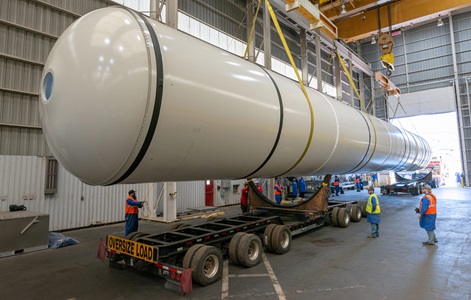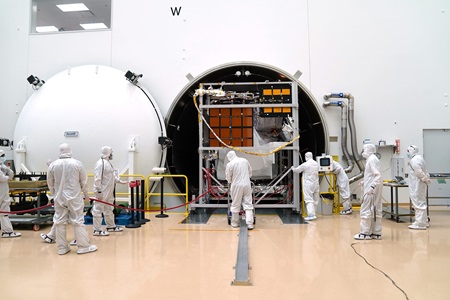Digital Engineering Triumph

By: Albert McKeon
As headlines announce exciting expeditions into space — a new rover's exploration of Mars and return trips to the Moon — an important digital engineering endeavor is happening at the edge of Earth's atmosphere.
Northrop Grumman is pioneering the field of satellite services, creating a line of industrious spacecraft that refuel and repair satellites and allow telecommunications companies, militaries and other businesses to prolong the life of their expensive space technology. The company established a new strategic venture called SpaceLogistics LLC as the exclusive distributor of these products and services.
This innovative approach to satellite servicing first takes shape on the ground. In testing facilities and offices, Northrop Grumman employees make the most of collaborative digital tools and model-based systems engineering (MBSE) to develop the systems behind innovative satellite servicing vehicles.
The integration of digital technology with model-based approach to engineering is making a mark — increasing collaboration between employees and partners around the world and creating more efficient, agile ways to build complex space systems.
"Digital transformation has continued to accelerate," Dr. Joanne Woestman, a director of programs at Northrop Grumman said of the approach. For her and her colleagues, the evolution of digital engineering is enabling more efficient development of reliable products and systems for satellite services.

Refueling and Repairing on the Edge of Space
The early successes of satellite servicing could cement the "new" way of work.
In 2020, a Mission Extension Vehicle (MEV) developed by Northrop Grumman successfully docked with Intelsat satellite IS-901 and, acting as an additional engine, corrected its orbit. The craft, named MEV-1, will give the satellite five more years of service by providing additional propulsion and pointing it toward its targeted antennas on Earth. A second mission saw MEV-2 dock with another Intelsat satellite, IS-10-02, in spring 2021 — also with the mission of extending service by five years. A selling point of the vehicles is they have a long shelf life up to 15 years and can move around from satellite to satellite, supporting several companies' programs.
But it doesn't end with the MEV. Restoration and repair are at the heart of the company's wider satellite services program.
The first Mission Robotics Vehicle (MRV) is expected to launch in 2024 and will be a mechanic in space. With two long-reaching robotic arms that were provided by DARPA, the MRV can inspect, repair and augment satellites. Between getting hit by the debris of other satellites and suffering from ordinary wear and tear, satellites need maintenance, or they'll go dark.
The MRV can also position smaller Mission Extension Pods (MEP) onto satellites. The MEP is a mini version of the MEV that will provide additional propulsion. Unlike the MEV, it cannot correct the attitude of a satellite, but it can support its positioning in space. An MEP will also extend the life of a satellite by about six years.
Northrop Grumman intends to create many MEPs, Woestman said. Although foundationally identical, MEPs will have varying components to align with the different types of satellites in space. That's why it will help to develop the MEP, as well as the MRV, using digital technology and model-based systems engineering.
As Woestman explained, the more it's linked to a model, the easier it is to manage the variations in the product line.

A New Approach to Digital Engineering
In order to keep up with the pace of rapidly advancing threats, customers expect products to be developed not just quickly but with a flexibility that can accommodate in-the-moment adjustments and large-scale changes, too. Hurdles are to be cleared fast, and delays and cost overruns are to be avoided.
A key component of digital transformation, model-based systems engineering (MBSE) builds for that quick and flexible moment. As opposed to document-based systems engineering, in which different stakeholders hold several viewpoints and contribute differing documents that have to be reconciled, MBSE puts the model itself at the center of work, creating a single source of truth.
MBSE and digital tools are ideal for ensuring the development of MEP and MRV, Woestman said. For example, with each MEP, Northrop Grumman will perform analysis to confirm the details of its attachment to and service of a specific client satellite. A particular working model will verify the software written for the docking and servicing processes and ensure that the MEP and its client satellite will successfully interact and operate long before the two eventually meet in Geosynchronous Equatorial Orbit (GEO).
Indeed, a digital approach to MBSE delivers real-time results that accelerate projects without sacrificing quality control.
"It lets us know we're doing a good job of not only the design as intended, but also the parallel design for fail-safe," Woestman said. It also simplifies, as much as possible, nuanced tasks such as testing the complicated interaction between the MRV's hardware and its software and the verification of the systems behavior in the unique environments of space. Algorithms for movement on Earth don't apply in space — digital-based MBSE lets engineers work through those differences.
Moving Toward All-Digital Collaboration
Woestman's team is already realizing the benefits of MBSE. The approach is enabling them to constantly learn from their work and see how they can quickly apply those lessons.
"It enables more scenario thinking, more what-ifs," she said. "What if we change this, and what if we did this? It also improves communications across larger teams. Usually, it's difficult to align a hundred different people on a project — and even crazier when they're working across the world.
"This approach increases confidence in the product," she added. "You can get a better result and capture more technical interaction."
Next Generation of Satellite Servicing Products: Mission Robotic Vehicle and Mission Extension Pods
More innovation stories
Read all stories about advanced technology and innovation >>


